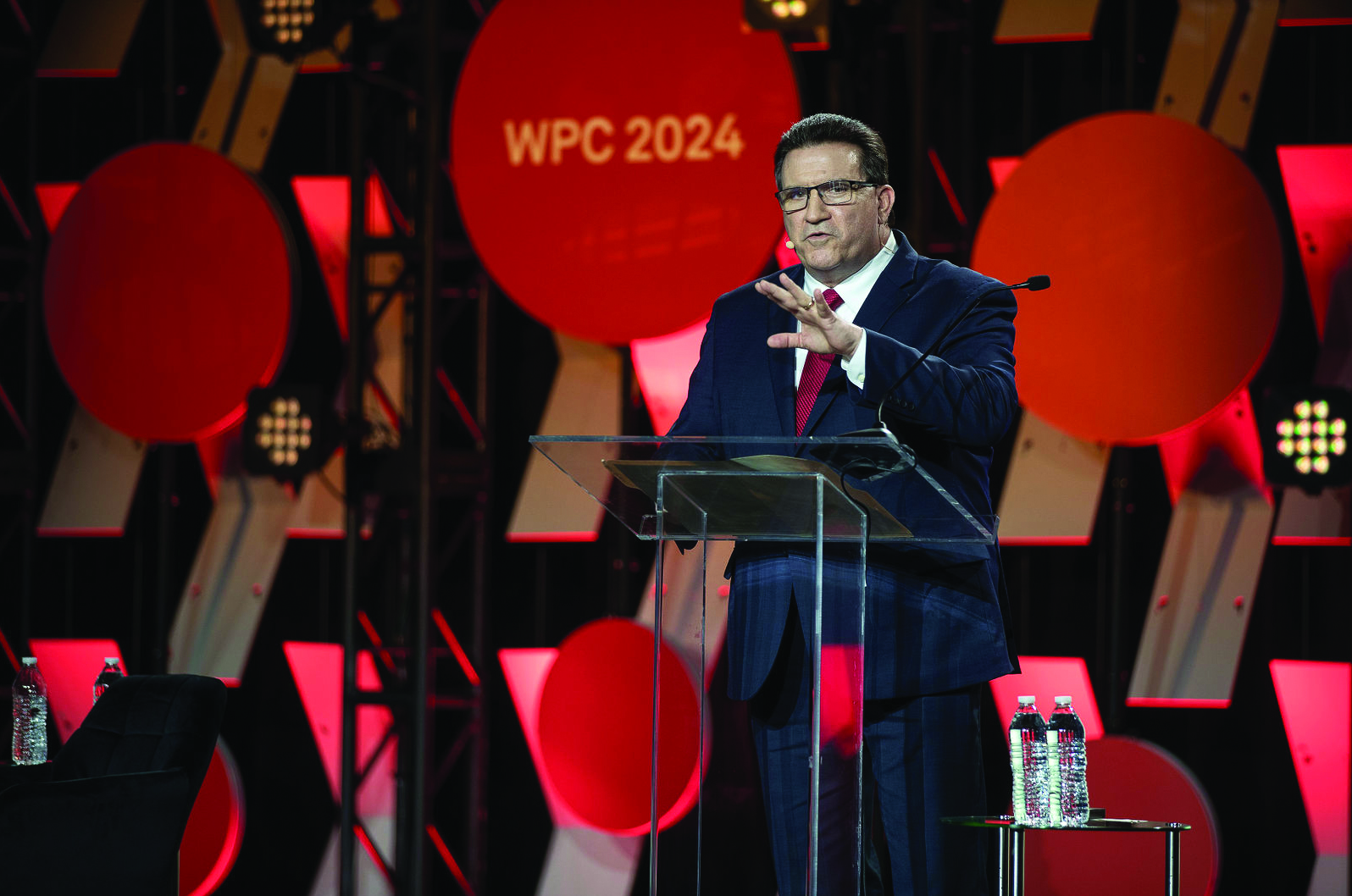WPC: Carbon management now key factor in petchem investment

For petrochemical producers making capital investment decisions today, the management of CO2 emissions may have become as important as feedstock advantage, production technology, market access and integration, says Mark Eramo, global head/fuels, chemicals & resource solutions at S&P Global. Eramo discussed the implications of the energy transition for petrochemical investment at the World Petrochemical Conference by S&P Global in Houston.
"Where can I be competitive? I would say that for the last 10 years, there’s been a model of build low-cost and ship to high-demand regions," said Eramo. "Today we’re saying that now there’s a fifth consideration, and that is, how do I provide effective carbon management? How will that change the footprint over the next 10 years when it comes to the location strategy of petrochemical assets? Maybe the model stays the same. Or does the fact that you need an effective carbon management strategy in order to get the financing you need or approval from the board [mean] that now your location strategy is going to have to be slightly different than it was in the past?"
Eramo said the petrochemical industry is committed to lowering carbon emissions. However, doing so is "a global balancing act complicated by geopolitics," he told attendees. "It’s about curtailing demand for high-intensity carbon energy while decarbonizing supply and then trying to build this green-energy economy of the future," he stated. "And probably the most important thing […] is that energy security and energy affordability are at the front of the line in creating this multidimensional energy transition dynamic."
Most of the world’s population remains eager to improve their living standards, and demand for energy and consumer goods will necessarily increase. "You have to continue to supply the growing needs of a growing population with the assets you’ve got on the ground," Eramo noted. "Those are hydrocarbon-based assets for the most part. So this balancing of capital to make my current assets profitable and meaningful while I try to transition to this cleaner greener energy-based future is the balancing act that these executives are facing."
Decisions around capital investment must balance the need for an energy transition not only with the broader needs of society but also with the financial realities that place limits on the path and speed of progress.
"This set of assets has to be very profitable, and it has to fund the ability to get to this green future — the ability to bring in renewable energy, to look at on-site electrification or go with carbon capture, to go with hydrogen, [or] deeper integration into chemicals. That hydrocarbon-based business has to be able to fund the cash flow that enables me to make the investments that get me to a lower carbon future."
"The pathway to net-zero requires us to rethink business models and evaluate low-carbon inputs along with end-of-life solutions for consumer goods," said Eramo. Incentives will be more effective than penalties, he said, because they attract capital investment. "I also believe a more pragmatic approach makes good sense," he added, such as asking consumers to focus more on managing their own waste.
Eramo stressed the need for multiple solutions. "We have to have hydrocarbons for […] the consumer goods that enable modern living and advance the human condition," he continued. He also argued for carbon pricing. "I’ve heard this multiple times last year and this year: Give me a carbon price, and then let the industry run off that, and we’ll make the decisions that we need to in terms of dealing with carbon," he said.
"When you align informed policy, market mechanisms and technology, that’s when things are most successful," Eramo said. "When you align those three things, you find a resurgence in investment in a region of North America called Alberta that hasn’t seen that kind of investment for decades. When you don’t have that alignment, what you get is some confusion, some hesitation, some misunderstanding, and not investment."
This article was first published in chemweek.com.
News
Geopolitical pressures — including rising resource nationalism and a year in which over 50% of countries will be having elections — as well as inflationary pressures have sent energy transition progress into “discord.” A specialty chemicals panel session held March 19 at the World Petrochemical Conference by S&P Global in Houston, Texas, tracked the challenges and opportunities of the energy transition for the industry. Speaking at the session, Roman Kramarchuk, head of climate markets and policy analytics at S&P Global Commodity Insights, said that if the short-term scenario continues, global temperatures could rise 2.4 degrees Celsius by 2100, far above the Paris Agreement’s goal of a 1.4-degree increase. “Over the past few years, we’ve certainly been trending more towards our ‘discord’ scenario,” Kramarchuk said. “We’re trending toward a longer runway for fossil fuels and less [greenhouse gas (GHG)] emission reductions. This is a case of less GDP growth, less trade and less technology transfer.” Since 1990, world GHG emissions have grown 45%, with mainland China, India and the Middle East representing the biggest increases in emissions, at 304%, 241% and 181%, respectively. Over the last 25 years, the Commonwealth of Independent States and the EU have cut their emissions the most, with decreases of 39% and 31%, respectively. The US has cut emissions 1% since 1990. Of S&P Global Commodity Insights’ three energy and climate scenarios, only one, “green rules,” has global temperatures near the Paris Agreement’s 1.5-degree goa, with an expected increase of 1.7-degrees Celsius by 2100l. The “green rules” scenario, however, assumes more technology transfer, cooperation and policy-driven outcomes than is currently happening. “2030 is not that far away,” Kramarchuk said, “and when you think about what the energy transition will take, solar panels can be constructed fast, but anything beyond that — like an onshore or offshore wind plant or a nuclear unit — we’re getting into lead times of 5, 10, or 20 years.” While the US Inflation Reduction Act has helped speed these transformational energy products along, there are still a lot of slowdowns in permitting, especially in Europe. “We joke that there needs to be a ‘Complexity Reduction Act’ in Europe to move things forward,” Kramarchuk said. Harald Schwager, deputy chairman of Evonik Industries AG’s executive board, added that companies are stuck in a hard place. Evonik has signed power purchase agreements (PPAs) to be powered fully by renewable energy by 2030. “The question will be, will production capacity be hampered by the regulatory process and will we have sufficient infrastructure in place to transport enough renewable power for site demand by then,” Schwager said. Distant peaks Commodity Insights’ energy and climate base case pegs the peak years for coal, oil and gas demand to be 2022, around 2030 and 2040, respectively. “When there is a surprise need for energy,” Kramarchuk said, pointing toward the COVID-19 pandemic and a drought in China, which caused a boost in coal usage, “fossil fuels fill that need.” However, “there’s more investment in renewable capacity than we’re seeing in upstream oil and gas,” Kramarchuk said. Under all scenarios, renewable electricity will be the lion’s share of newly generated energy sourcing. Rebecca Liebert, president and CEO of Lubrizol Corp., said that it is the duty of specialty chemical producers to be agile and proactive in bringing innovative and more sustainable products to market. “Political and technical factors are all things we must account for in our bring-to-market timelines. And we get it right a lot of times, but we get it wrong some of the time. Sometimes you get to market before the market is ready for your product. And I think that’s great, to have a solution on the shelf as the market comes along.” Schwager agreed: “In the specialty chemical industry, we have more good ideas than we have money. And there’s no regret on moves for improved efficiency.” While there has been little movement on target setting and market-based mechanisms for growing renewable energy, COP28’s first global stocktake committee called for “countries to contribute to triple global renewable energy capacity and double global energy efficiency by 2030.” “Even though we are heading for the discord path right now, with all the technology solutions and innovation pushes, we’ll be shooting up ahead towards the ‘green rules’ scenario in the long-term,” Kramarchuk concluded. This article was first published in chemweek.com .

News
Two NGOs appealing against permits Initial plan was to start end of 2023 BASF is facing a delay of the operational start of its newly built precursor cathode active materials (pCAM) plant in Finland due to two non-governmental organizations (NGOs) appealing against already-granted permits, a spokesperson for the German petrochemicals company confirmed to S&P Global Commodity Insights Feb. 27. BASF initially aimed to start commercial production at the Harjavalta plant at the end of last year. “The necessary permit to operate this plant has been granted last year by the relevant authorities,” the spokesperson said. “However, two NGOs have filed an appeal against the already granted permit. Next steps and timing will depend on the furtherance of the judicial process before the Vaasa Administrative Court,” said the spokesperson. The pCAM plant will use renewable energy resources, including hydro, wind and biomass-based power and will be supplied with nickel and cobalt from Nornickel’s adjacent refinery. The plant is part of BASF’s plan to supply the battery industry and subsequently automotive industry with lower carbon emission cathode active material. Platts, part of S&P Global Commodity Insights, assessed cobalt metal in-warehouse Rotterdam at $15/lb on Feb. 26, stable from the previous assessment Feb. 23, while the nickel-cobalt black mass EXW Europe payables was at 54% Feb. 26, also stable.

News
The petrochemical landscape has been transformed in recent years by new technologies and the global energy transition, resulting in numerous production pathways and the development of more sustainable products. S&P Global Commodity Insights has created Chemical Connections , an interactive chart which shows the links between chemicals, from upstream feedstocks to derivative products. The second slide offers a map showing our price assessments and benchmarks for chemicals across the value chain around the world. These prices are used by market participants daily to write contracts, monitor their markets and achieve full transparency around transactions.